Breast Reduction
Breast Reduction Surgery in Carmel, IN
Dr. Barry Eppley has extensive experience helping area breast reduction patients achieve an improved breast contour and position. Please visit the before and after breast reduction photos page to see examples of this procedure.
WHO IS A CANDIDATE FOR BREAST REDUCTION?
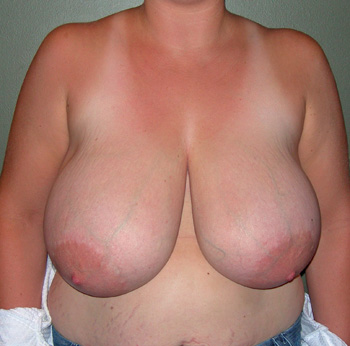
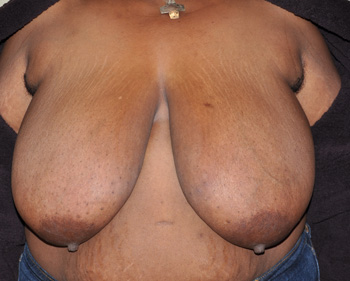 Women with large breasts that sag or are disproportionate to their body shape often experience pain in the back, shoulders, and neck from their excessive weight. Furthermore, their shoulders may develop painful grooves in the skin from the bra straps which have to support the heavy weight of the breasts. Excessively large breasts can also make certain physical activities very difficult and exercise virtually impossible. Available clothing options may be severely limited and often embarrassing. Fortunately, modern plastic surgical techniques make it possible to help with this problem through a breast reduction procedure. This procedure can effectively reconstruct the breasts to a more proportionate size and an uplifted rounder shape.
Women with large breasts that sag or are disproportionate to their body shape often experience pain in the back, shoulders, and neck from their excessive weight. Furthermore, their shoulders may develop painful grooves in the skin from the bra straps which have to support the heavy weight of the breasts. Excessively large breasts can also make certain physical activities very difficult and exercise virtually impossible. Available clothing options may be severely limited and often embarrassing. Fortunately, modern plastic surgical techniques make it possible to help with this problem through a breast reduction procedure. This procedure can effectively reconstruct the breasts to a more proportionate size and an uplifted rounder shape.
HOW IS BREAST REDUCTION SURGERY DONE?
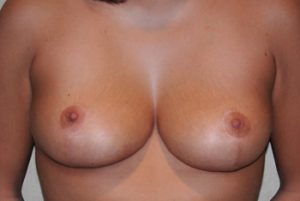 Almost all breast reduction patients require the use of a keyhole technique that results in an inverted T or anchor scar pattern. This is necessary to reduce the breast in both a vertical and horizontal dimension and to lift it back up on the chest wall. The improvement in symptoms from large sagging breasts is as much due to its repositioning on the chest wall as it is from the weight of the breast tissue removed. It is important for each patient to realize the location of the scars on the breast and understand that the scars are an aesthetic trade-off for more uplifted and smaller breasts.
Almost all breast reduction patients require the use of a keyhole technique that results in an inverted T or anchor scar pattern. This is necessary to reduce the breast in both a vertical and horizontal dimension and to lift it back up on the chest wall. The improvement in symptoms from large sagging breasts is as much due to its repositioning on the chest wall as it is from the weight of the breast tissue removed. It is important for each patient to realize the location of the scars on the breast and understand that the scars are an aesthetic trade-off for more uplifted and smaller breasts.
BREAST REDUCTION SURGERY DOES NOT USUALLY INVOLVE REMOVING THE NIPPLES
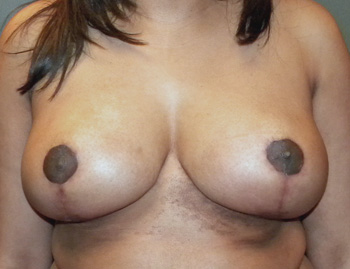 Most breast reduction techniques do not involve the removal of the nipple in the procedure. This is a common misconception. The nipple usually remains attached to the uplifted breast mound so its color, sensation and the ability for nipple erection are not usually affected. Many breast reduction patients will need the size of the surrounding areola reduced as it, like the rest of the breast, is also enlarged.
Most breast reduction techniques do not involve the removal of the nipple in the procedure. This is a common misconception. The nipple usually remains attached to the uplifted breast mound so its color, sensation and the ability for nipple erection are not usually affected. Many breast reduction patients will need the size of the surrounding areola reduced as it, like the rest of the breast, is also enlarged.
There are uncommon indications for a breast reduction technique known as free nipple grafting. In this breast reduction technique, the nipple-areolar complex is removed and put back on the newly repositioned and reduced breast mound as a full-thickness graft. This will result in permanent loss of nipple sensation and sometimes its color in patients with darker skin pigments. This technique is used when the breasts are extremely pendulous (hang as low as the bellybutton or even the waistline) or the patient wants a very small breast size result from initially very large breasts. This technique is done when the plastic surgeon has concerns that the nipple-areolar complex may not survive if left attached to the reduced breast mound.
For women who need only smaller amounts of breast reduction and limited amounts of lifting, periareolar breast reduction with liposuction can be done. This avoids scars on the breast skin as they are limited to only around the areola. But without skin removal the amount of breast reduction and lift will be very limited…and usually is not enough to justify this type of breast reduction approach.
BREAST REDUCTION CREATES SCARS
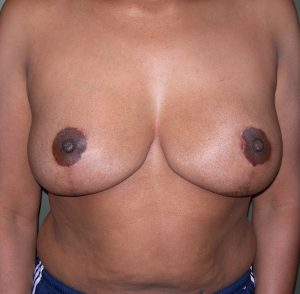 Breast reduction of any significant amount requires the classic anchor style or inverted Y shaped scars as a result. It is these scars which have created the lift part of the reduction. Every women who wants her breast size reduced and the nipples and mound reshaped must carefully consider the trade-off of these scars, These scars can be quite pronounced due to their redness in the first few months after the procedure. It can take up to a year after the surgery until the scars have matured and faded into their final appearance.
Breast reduction of any significant amount requires the classic anchor style or inverted Y shaped scars as a result. It is these scars which have created the lift part of the reduction. Every women who wants her breast size reduced and the nipples and mound reshaped must carefully consider the trade-off of these scars, These scars can be quite pronounced due to their redness in the first few months after the procedure. It can take up to a year after the surgery until the scars have matured and faded into their final appearance.
In addition to helping area breast reduction patients, Dr. Eppley performs other breast surgeries to help breast augmentation and breast lift patients achieve a shapelier and more voluptuous body contour. Breast procedures are also often part of mommy makeover surgery.
Breast Reduction – Before Surgery
At the initial consultation, the breasts are initially examined and their size, shape, and position of the nipples are measured and recorded. Preoperative mammograms may be required and photographs will be taken. The differing types of breast reduction procedures are reviewed and the most effective surgical approach is chosen.
The avoidance of all drugs that contain aspirin two weeks prior to surgery is necessary to avoid the possibility of excessive bleeding after surgery. The cessation of smoking two to four weeks prior to surgery is an absolute must as smokers have more difficulty with wound healing which may be a particular problem in the long incisions which are frequently used in breast reduction surgery.
Breast Reduction – Operation
The breast reduction procedure is performed as either an outpatient procedure or an overnight stay in a hospital or surgical center setting under general anesthesia. Prior to the patient being taken to the operating room, surgical drawings are made on the breasts with the aid of a measuring tape and marking pen to indicate where the incisions will be made and how the excessive breast tissue and skin will be removed.
While a variety of breast reduction techniques exist, one of the most common is the ‘keyhole’ pattern skin reduction. This creates a new nipple position higher up on the existing breast mound, allows the removal of breast tissue and skin from both sides of the breast, and results in an ‘inverted-T’ scar pattern extending down from the nipple to the lower breast fold.
The breast reduction procedure takes a variable amount of time dependent upon the extent of the procedure. Typically, it may take between two and three hours to complete. Liposuction of the lateral chest wall up to the armpit (bra roll liposuction) is often necessary to get rid of the excess fullness in this area. Bra rolls will not be eliminated by the breast reduction itself. This part of the breast reduction procedure is not covered by insurance (liposuction). These additional costs are the responsibility of the patient.
Breast Reduction Recovery
All breast reduction incision are closed with dissolvable sutures and are covered by tapes. A surgical bra will be placed at the completion of the procedure with soft gauze along the incision sites. Surgical drains are usually used and are removed within one or two days after surgery. The patient may be sent home and seen the next day for drain removal.
Surprisingly, pain is usually only moderate and is more of a soreness which is managed by oral pain medication. Some swelling and bruising of the breasts can be expected. Suture removal is not usually necessary. Most commonly, sutures are placed beneath the skin and do not require removal. Physical activities, particularly strenuous exercise, should be avoided for one month after surgery. Scars from the incisions, although permanent, take up to one year to fade to a more normal skin color.
Significant complications from the breast reduction procedure are quite rare. Common minor problems include delayed healing of the incisions on the breast mound and around the areola and the potential for loss of portions of the nipple and areola. A perfect match in size and shape between the reduced breasts is difficult to achieve.

North Meridian Medical Building
Address:
12188-A North Meridian St.
Suite 310
Carmel, IN 46032
Contact Us:
Phone: (317) 706-4444
WhatsApp: (317) 941-8237
